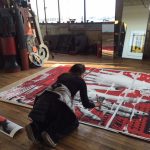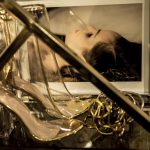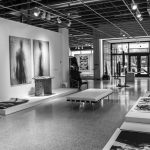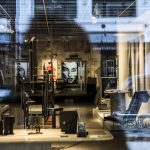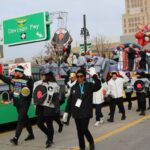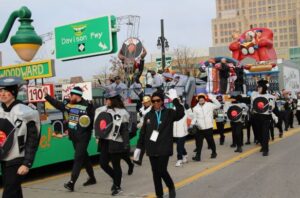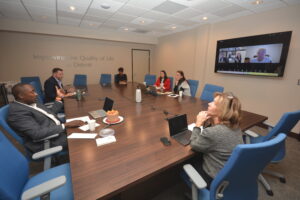“It’s like a fishbowl,” says Lisa Spindler, referring to her downtown studio. During the day, the tinted windows allow for privacy. While at night, the same storefront windows open into a multi-thousand square foot expanse, Lisa Spindler Studio—a space that, even Lisa admits, looks more like a gallery than workspace.
The rooms are split into many stories: a dining room, multiple tables displaying small sculptures and assorted artifacts, another dining table covered in prints. Floor to ceiling shelves display objects easily mistaken for merchandise. Large art sculptures are placed throughout. A hidden back room contains more art and artifacts, lush couches and draping fabric, a gypsy sanctuary.
Even the elevator shaft, no longer in use, is filled with art.
Lisa pulls out oversized digital prints
“I started using photoshop about five years ago, but I didn’t know what I was doing.” The colorful prints are more reminiscent of Warhol silkscreens than the intimate character studies that have defined much of her career. This is data, manipulated into brilliant repeating shapes—another way for her to mark the changes of a city which she has documented since the 1980s.
These changes are marked in the studio walls. Layers of paint add texture and color.
The building was once a women’s clothing store. After that, a music school. Now Bedrock owns it, and Lisa rents it. If her time in the city has taught her anything, it is to savor the moment because it won’t last forever, this is life. Not just Detroit.
To the left of the elevator shaft is the workroom
A third of the elevator shaft is taken up by a table covered in gelatin silver prints and tools of the trade. The back wall is filled with boxes. Negatives. “All my work dating back to the beginning of my career.” Before moving into this studio two years ago, everything was in order and organized by year. Now, it’s a mess of history that gives her anxiety to think about.
There are printers. File cabinets. Photographs on the wall, falling onto the ground—character studies, spanning the length of her career. “I’m getting back into them,” she says.
Her models are friends, acquaintances, and, sometimes, strangers. “This young woman stumbled into the studio one day. She’s gorgeous. Works in a credit union.”
In the back of the main space, sits her desk. The place where she spends most of her time. During our conversation, she pauses to check her computer for references or bits of inspiration: a friend’s shop, a piece of music, a line from an email. Having devoted her life to photography, gathering and synthesizing details is instinct—”I can tell you where to set the camera without even looking at it. By looking at the light.”
Lisa Spindler Studio is one of the most inviting spaces downtown
A stylist’s dream. Not open to the public. Although she wants to share her creation with as many people as possible, this is where she works. Guests are welcomed in as often as time permits: these days mostly friends and European tourists who stumble to the door. For a while, she kept her doors open to the street on certain days.
“I remember two elderly women, retired school teachers, walked in here. And they loved it. They said ‘You must be so wealthy’, and I choked for a minute. Over the years, I’ve been robbed. I’ve been on WIC food stamps, Medicaid. I’ve had a lot of things to get through.
I brought them to the back of the studio and showed them a few things. I said ‘I’m not rich, but I’m rich in what I can show you. I’m lighting it beautifully. It’s not an illusion, but I do know how to make something look great.’”
The following interview was conducted by email, after a two-hour conversation at Lisa Spindler Studio where time and focus were lost. Because Lisa has that sort of sway over people.

Collection of work in Lisa Spindler Studio
CV Henriette: When did you decide to pursue art?
Lisa Spindler: When I was in fourth grade. I had an amazing teacher named Mrs. Krentzin who was also my art teacher. I was so happy doing art projects with her. She used to wear a different surrealist pin on her outfit each day that was made by her husband Earl Krentzin, who was a very prominent metalsmith and sculptor. I used to make her hand made presents to show how much I loved her and the class. She was amazing.
CVh: Was there ever another path?
LS: No. Although I considered being an elementary school teacher when I was younger. I knew I wanted to be a photographer from a specific moment when I was in my junior year in high school. From that moment on I knew what I wanted to do.
CVh: Music seems to be important to you. Do you play any instruments?
LS: I don’t play any instruments but always loved music and dancing from a very young age. Music was always playing in our home, and in our car, and my parents brought us to so many concerts in Detroit when we were kids. I remember loving the Beatles. My earliest memories of serious music obsession go back to kindergarten.
CVh: How has music influenced your work over the years?
LS: I feel that music is the most powerful art form. I usually go through different phases of listening to different types of music, depending on what I am feeling and creating.
In one of my past series of complex color metal structures with ideas of buildings in 2014, I specifically listened to a young artist from Germany who grew up in a forest. He makes ambient yet upbeat techno music that I found influenced and inspired the entire body of work. My dream would be to someday bring him to Detroit to do this music in an amazing Detroit location amongst the body of work I created.
CVh: How has Detroit influenced your work?
LS: Through the years Detroit has forced me to find beauty and meaning in the things around me. Whether it was the industrial grittiness, the desolate city throughout the years I was working downtown, the poverty I witnessed much of the time, the music, and, most importantly, the people. All of these have touched me deeply and have affected the work I have created. There are bodies of work I have not shown or released that will be important in the years to come. One of them is of a woman I knew named Jackie, I look forward to sharing that
CVh: Do you remember the first studio you had?
LS: Yes, it was on the 6th floor of a building on the corner of Grand River and Broadway. I think I paid $200.00 a month and shared it with a friend of mine named Drake. It was a small room with lots of light, and we built a darkroom in it. And there was a little old lady that ran the cage elevator. Gilda Snowden and Jon Strand were in the building. I never knew them well at the time, but they were very important artists.
CVh: You’ve had a lot of studios over the years. Most memorable?
LS: I’ve had 12 studios so far…. the memorable being the one I had in my home at Garden Court. It was a magical place to live and work, and the apartment was large enough to have a studio in the dining room.
CVh: Your current studio looks like a gallery—although it is not. Have you always had this relationship to space? Have you always collected things?
LS: I have always surrounded myself with things that inspire and intrigue me, or that I found to be beautiful. I like creating intimate environments that are inspired by art. The energy has to be right in the space. it doesn’t matter if it’s large or small. I actually prefer a small space. It has been difficult at times trying to create the right feeling in larger spaces.
My current studio took almost two years to get right. It’s finally the best it can be.
CVh: Did you ever imagine yourself in the middle of a booming downtown?
LS: Never.

A monumental work of Lisa’s
CVh: What are your favorite parts of Detroit? Why do you choose to stay here?
LS: I love Belle Isle so much. I also love Indian Village, the Riverfront, driving down Michigan Ave., I see what is happening and changing. Driving around and seeing all the buildings I remember, I’m curious to see the change evolving to them.
It’s surprising how much I’ve enjoyed meeting some of the younger, vibrant people who are moving here. I always wanted to be somewhere else but I’ve realized this is where I am meant to be. Maybe in the future, I will go west—but Detroit is always in my heart and home.
CVh: Detroit has changed. It’s changing. What do you want people to remember about the city?
LS: This city has incredible strength and beauty, event against all the odds. I have witnessed it in my life here. Incredible creativity is rooted here. I want people to remember to respect the people who have lived here and continue to live here. It is important to not lose the energy that somehow manages to vibrate here, even in the most challenging and difficult times. I have never met people like the ones I have met in Detroit. It’s becoming a different city now—and faster than any of us ever imagined could happen.
CVh: What do you want to preserve?
LS: I wish we could have preserved the Boblo boats. I worked on the boats in the 1970s and it was such a beautiful memory and experience. That loss was huge in my eyes for the people of Detroit.
I want to preserve what is important, and that is a very long discussion! Let’s not lose the art and architecture. Let’s build better communities for our families and, mostly, our children.
CVh: How has your practice evolved with the city?
LS: As I get older, I find that people are reaching out to me about projects and ideas in the city, and I am happy to feel that. That comes with years of working hard and dedication. I also have been documenting more of this rebuilding or change in our city, as I feel it is both a historical and extremely important time that I never expected would really happen.
CVh: What’s next?
LS: That is the mystery of life. I don’t know, but my heart and intuition tell me to use my vision and experience to work on a project or with people to help make positive changes in work I believe in. The road I chose has been long, but I would be grateful now to be able to concentrate on work that is affecting and helping other people’s lives who are less fortunate. That, ultimately, is what I feel that’s most important to me.
Lisa Spindler’s clients include NY Times Magazine, Geffen Records and, locally, the Detroit Foundation Hotel, among an impressive and exhaustive list. Those interested in her work, should click here to schedule a studio visit.





